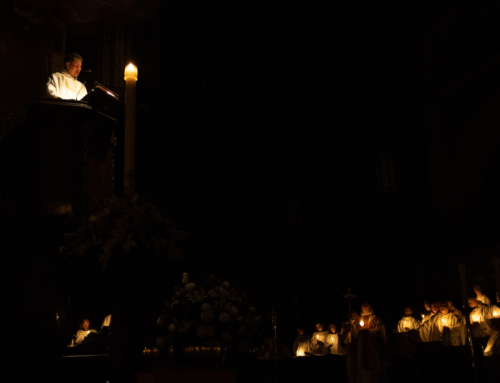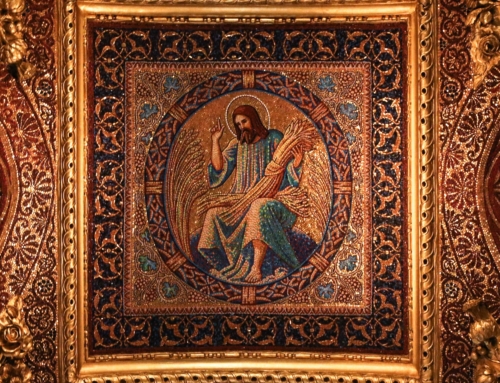This is part of a series entitled, “Preaching: Feeding Fellow Beggars.” Read the series introduction here. To see other posts in the series, click here.
When was the last time that a homily made you cry? Tears of frustration and boredom do not count. What I am asking is this: when was the last time that preaching moved you so greatly that you shed tears of love? Perhaps it was at Mass, a holy hour, a conference, a piece of writing, or even listening to a podcast; whatever the context, when was the last time that a preacher broke open the Word in such a way that, moved to tears, you made your own the words from the author of the Letter to the Hebrews:
Indeed, the Word of God is living and active, sharper than any two-edged sword, piercing until it divides soul from spirit, joints from marrow; it is able to judge the thoughts and intentions of the heart. (Heb 4:12)
I suspect it has been awhile, or perhaps never, since a Catholic preacher moved you so greatly that you shed tears. And yet, for Saint Augustine, a pillar of preaching and eminent doctor of the church, that members of his congregation would not burst into tears, loud wailing, or groaning, on a regular basis, would be deeply disturbing. Augustine, like many Fathers of the Church, preached in such a way as to unleash from the Sacred Scriptures the divine power of God’s voice—the voice that “cracks the cedars . . . strikes with fiery flame . . . shakes the desert . . . and strips the forests bare” (Ps 29:5-9). Augustine’s preaching often elicited tears, wailing, groaning, and shouts—so much so that sometimes Augustine even had to quiet his congregation down! This was exactly what Augustine wanted, however. He wanted his congregation to react—and to react strongly to his preaching. But why? Was Augustine just an emotional manipulator? Was this an example of an educated and privileged man wielding his power to brainwash ordinary people with man-made myths in order to reap financial and societal rewards?
Augustine wanted his hearers to cry, shout, groan because this was the best indication that his preaching was in fact registering in the minds and hearts of his congregants. Augustine’s goal as a preacher was to make the people of God shed tears—not because he wanted to manipulate people, but because tears are a good outer sign of inner persuasion. They are a sign of the conversion of the heart—that movement away from slavery to the things of the world and towards freedom in God.
Augustine outlines his most comprehensive and systematic treatment on Christian preaching in his De Doctrina Christiana (On Christian Doctrine). In book four, Augustine encourages the study and use of rhetoric in preaching to help preachers eloquently communicate the meaning of the Scriptures. He argues that the study and use of rhetoric, the art of persuasion, particularly befits the preacher and teacher of the faith because what the Christian preaches and teaches is nothing other than the truth, something which especially deserves eloquent communication and defense. By using the art of rhetoric, the Christian preacher and teacher uses the best tools possible in service of the saving truth of Jesus Christ.
If advocates of falsehood use rhetoric to “move and force minds . . . into error,” then Christians who have the certainty of God’s revealed truth and the eternal well-being of their neighbors in mind should use rhetoric all the more for the sake of the salvation of souls. Whereas many use rhetoric to manipulate and ultimately to enslave others, Christian preachers use rhetoric to dispose others to hear the voice of the Lord, to be moved by it, and to enter into the fullness of life in God by acts of faith, hope, and love. For persuasive preaching it is not enough that the listener knows and delights in what is true, rather they must be moved to act, moved to love what is good.
Outward movement, some kind of action, on the part of the listener, then, indicates both the eloquence and effectiveness of the preaching. In particular, Augustine highlights tears as an outer sign of the inner persuasion towards which preaching is primarily aimed. On the first point Augustine says, “indeed the crowd eager for understanding is accustomed to signify whether they understand by their movements” (De Doc. 4.25). The preacher, then, knows that his congregation has received what he has communicated when they show some sort of outer movement. It is only then that the preacher can move on from the topic. However, if the preacher wants to know whether or not his congregation is being persuaded, he needs to look for tears. Augustine relays this exact point with a personal story of when he was preaching using the “grand style,” the most eloquent and evocative of rhetorical styles:
However, for the most part the grand style by its weight diminishes voices and causes tears to be shed. Besides, when I was in Caesarea Mauritania dissuading the people of civil war . . . I acted and signified grandly, in as much as I was able to, that I might expel and rip out such cruel and ancient evil from their hearts and habits by my speaking. I had not judged that I had done something when I heard them shouting but when I saw them crying. For by their shouts they showed they were being taught and delighted, but it was by their tears that they indicated they were persuaded. (De Doc. 4.24.53)
Augustine’s personal anecdote reveals several things. First, it shows the usefulness of rhetoric for the task of preaching. Recognizing the need to persuade the citizens of Caesarea Mauritania from engaging in a civil war, Augustine employed the most powerful style of rhetoric, namely, the grand style, not just to teach or delight, but to move his hearers to love what is good, that is, to love peace and the common good over their individual good. Second, it shows the value that Augustine places on the outer sign of tears as an indication of the inner persuasion of his listeners. Shouts show that “they were being taught and delighted,” but “tears . . . indicated they were being persuaded.” The question still remains, however: why are tears an especially important sign of persuasion? It is because Augustine sees the outer sign of tears as a good indication of conversion: when divine truth registers in the heart and moves it away from false goods to the true good, God. This was not just an abstract truth for Augustine. As we hear in his famous autobiography, The Confessions, it was his own experience.
Perhaps one of the most famous episodes in all of Western literature, the conversion of St. Augustine demonstrates that Augustine preaches and teaches about the importance of tears from his own experience of the efficacy of God’s Word. In book eight, Augustine recounts a vision of Lady Continence, a personification of both virtue and grace, who preaches to him and urges him towards chastity. She encourages him to imitate the lives of the saints, the men and women who had gone before him and prove that holiness is possible. Lady Continence also points out the final piece of the puzzle concerning Augustine’s inability to be chaste, namely, that he had been relying on himself only to find himself unreliable. She exhorts him to trust God and to give himself, including his unchastity, wholeheartedly to God that he might heal him.
It is from this encounter with God’s preacher, Lady Continence, and a subsequent encounter with God’s Word from Saint Paul’s Letter to the Romans, that pierces Augustine’s heart, converting him from unchastity and self-reliance to purity, humility, and love. The outward sign of his persuasion, Augustine humbly recounts, was “a vast storm bearing a massive downpour of tears” (Conf. 8.12.28).
It is clear that Augustine allowed his own experience of conversion to color his expectations in preaching and teaching, thus he looked for the sign of tears in his congregation as an outward sign both of God’s Word piercing hearts and gauging the effectiveness of his preaching as a vehicle of God’s razor-sharp Word. Augustine was convinced that God’s Word was living, effective, and being spoken to all that all men might be saved and come to the knowledge of the truth (1 Tim 2:4). He sought to use every tool available, including rhetoric, at the service of the truth, and he knew from personal experience that the outer sign of tears was a good indication that preachers were persuading their audience, that is, converting them from living in darkness and ushering them into the marvelous light of the Lord (cf. 1 Pet 2:9).
✠
Image: El Greco, The Tears of Saint Peter







